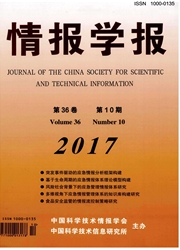

 中文摘要:
中文摘要:
近几年,各大社会媒体都在致力于提供良好的信息推荐服务,应对网络资源的增长和用户的个性化需求,然而数据稀疏性问题成为了影响推荐性能的主要障碍因素之一。本文在随机游走(RWR)算法的基础上进行了改进,提出了一种项目一标签导向的随机游走推荐模型(TRWR),针对特定用户分别在项目空间和标签空间中根据对象之间的相似性计算转移概率,进行有限步长的随机游走,在两个空间中都生成若干个待推荐项目,然后重新计算预测评分,最后对该用户进行个性化信息推荐。在计算对象之间相似性的过程中,本文采用了融合评分差异性和共同评分用户数的相似度计算方法。我们的实验基于MovieLens公开数据集,并与Top—N、DV和RWR这三种项目导向方法进行了对比,结果表明本文提出的模型提高了Precision值和Recall值,并使得MAE值有所下降。
 英文摘要:
英文摘要:
In recent years, information recommendation plays a more and more important role in Internet service. However, data sparseness has become one of major obstacles to the performance of recommendation. This paper proposes an algorithm named item-tag-based random walk recommender (TRWR) , which is based on the random walk recommender (RWR) algorithm. The idea in this paper is as follows: firstly, for a target user, it calculates transition probabilities between items and tags separately, then takes finite length random walks in the item space and the tag space in order to generate some recommended items. Secondly, it recalculates these items' scores. Finally, it recommends some items to the target user. When calculating similarities between items and tags, we introduce the number of same scorers . Experiments on MovieLens dataset show that TRWR algorithm outperforms three other item-oriented approaches which are Top-N, DV and RWR, because it improves the Precision value and the Recall value, at the same time decreasing the MAE value.
 同期刊论文项目
同期刊论文项目
 同项目期刊论文
同项目期刊论文
 Web-oriented OOV translation extracting approach through cross-language query expansion for English-
Web-oriented OOV translation extracting approach through cross-language query expansion for English- BioPPISVMExtractor:A Protein-Protein Interaction Extractor for Biomedical Literature Using SVM and R
BioPPISVMExtractor:A Protein-Protein Interaction Extractor for Biomedical Literature Using SVM and R Uncertainty sampling-based active learning for protein-protein interaction extraction from biomedica
Uncertainty sampling-based active learning for protein-protein interaction extraction from biomedica Improving the performance of bio-entity name recognition in biomedical literature via the contextual
Improving the performance of bio-entity name recognition in biomedical literature via the contextual Incorporating rich features to boost information retrieval performance: A SVM-regression based re-ra
Incorporating rich features to boost information retrieval performance: A SVM-regression based re-ra 期刊信息
期刊信息
